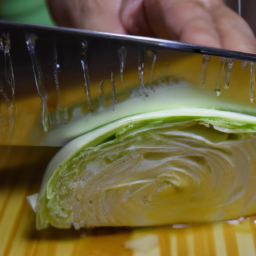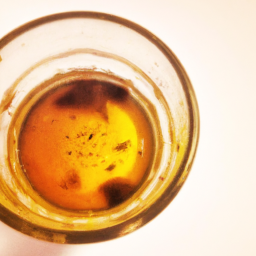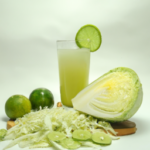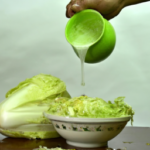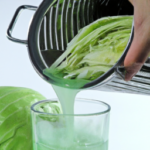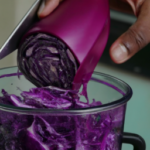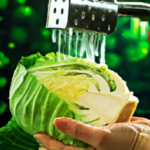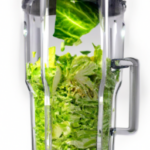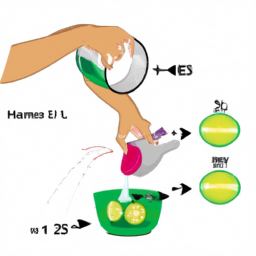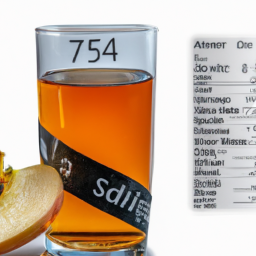As someone who is dedicated to maintaining a healthy lifestyle, I am always looking for new ways to incorporate nutritious foods into my daily diet. I recently discovered cabbage juice, a beverage that not only tastes great but also offers a variety of health benefits.
If you’re like me and want to try making your own cabbage juice, you might be wondering where to start. In this article, I’ll guide you through the process of choosing the right cabbage, preparing it for juicing, and adding flavor to your drink. I’ll also explain how you can maximize the nutritional benefits of your cabbage juice and offer some tips for incorporating it into your daily routine.
So, let’s get started!
Key Takeaways
- There are two main methods of extraction for cabbage juice: blending and juicing.
- Proper preparation involves cleaning and chopping the cabbage into smaller pieces.
- Recommended juice recipes include cabbage, carrots, and apples or cabbage, cucumber, and lemon.
- Adding herbs and spices can enhance the flavor of cabbage juice.
Why Cabbage Juice is a Healthy and Refreshing Drink
Cabbage juice isn’t just nutritious, it’s also a thirst-quenching delight. Drinking cabbage juice has numerous benefits for your body. It’s packed with vitamins C and K, as well as antioxidants that help fight inflammation and reduce the risk of chronic diseases.
Additionally, cabbage juice is an excellent source of fiber, which can help regulate digestion and promote a healthy gut microbiome. If you’re looking to incorporate cabbage juice into your daily routine, there are plenty of ways to do so.
You can drink it on its own, mix it with other vegetable juices for a tasty blend, or even add it to smoothies. Cabbage juice is also a great addition to soups and stews, adding both flavor and nutrition. Choosing the right cabbage is important, as different types of cabbage will have slightly different tastes and nutrient profiles.
Choosing the Right Cabbage
When picking out your ingredients for this vibrant drink, don’t forget to select a fresh and crisp head of green or purple leaves. Both types of cabbage are nutritious and offer a range of health benefits, but they differ in taste and appearance.
Green cabbage has a milder flavor and is perfect for those who are new to juicing or want a more subtle taste. On the other hand, purple cabbage has a slightly sweeter taste and a vibrant color that makes it a popular choice for juicing enthusiasts.
If you want to take your cabbage juice to the next level, consider opting for an organic head of cabbage. Although both conventional and organic cabbage offer similar nutritional benefits, organic produce is grown without synthetic pesticides or fertilizers, which can have harmful effects on your health and the environment. Plus, organic cabbage is often fresher and more flavorful than its conventional counterpart.
With the right cabbage in hand, it’s time to move on to preparing it for juicing.
Preparing the Cabbage
Before juicing cabbage, it’s important to prepare it properly. I start by thoroughly cleaning the cabbage, removing any dirt or debris.
Then, I chop it into smaller pieces that will fit easily into my juicer.
Finally, I decide whether to blend the cabbage for a smoother juice or juice it directly for a more concentrated nutrient boost.
Cleaning and Chopping
To get started on your fresh cabbage juice, grab a sharp knife and begin chopping the head into small pieces, allowing for easier blending. When cutting the cabbage, it’s important to use proper cutting techniques to ensure uniform pieces and to prevent injury.
Hold the cabbage firmly with one hand and use the other hand to slice through the head. It’s helpful to cut the cabbage into quarters first before chopping into smaller pieces.
After chopping the cabbage, it’s important to thoroughly clean the pieces before blending or juicing. Rinse the chopped pieces under running water to remove any dirt or debris. If desired, you can also soak the cabbage in a bowl of cold water for a few minutes to loosen any remaining dirt.
Once clean, pat the cabbage pieces dry with a clean towel or paper towel before adding to your juicing equipment.
Now that the cabbage pieces are cleaned and chopped, it’s time to move onto the next step of blending or juicing.
Blending or Juicing
Now it’s time to blend or juice the clean and chopped cabbage pieces. There are two main methods to extract the juice from the cabbage: blending and juicing.
Blending involves using a blender or food processor to puree the cabbage into a smooth liquid, while juicing involves using a specialized juicer to extract the liquid from the cabbage while leaving behind the fibrous pulp.
Both methods have their advantages and disadvantages. Blending retains more of the cabbage’s fiber content, which can be beneficial for digestive health and satiety. On the other hand, juicing removes the fiber and concentrates the nutrients, making it easier for the body to absorb them.
Ultimately, the choice between blending and juicing depends on personal preference and health goals. If you prefer a thicker, more filling juice, blending may be the way to go. If you’re looking for a more concentrated dose of nutrients, juicing may be the better option.
When it comes to adding flavor to your juice, there are a variety of options available. Stay tuned for the next section where we’ll explore some ideas for enhancing the taste of your homemade cabbage juice.
Adding Flavor to Your Juice
Spice up your cabbage juice by adding a pinch of salt and a squeeze of lemon for a tangy kick. Infusing flavors into your juice can make it more enjoyable to drink, and experimenting with herbs and spices can take your juice to the next level. Try adding a few sprigs of fresh mint or a dash of cayenne pepper for some extra zing.
You can also try adding ginger and turmeric for an anti-inflammatory boost. When adding flavor to your cabbage juice, it’s important to keep in mind that some ingredients may overpower the taste of the cabbage. Be sure to add small amounts at a time and taste as you go.
Once you’ve found your perfect flavor combination, sit back and enjoy the delicious and nutritious drink you’ve created. Now, let’s move on to maximizing the nutritional benefits of cabbage juice.
Maximizing Nutritional Benefits
By properly extracting the nutrients from your chosen vegetables, you’ll be able to optimize the benefits of your delicious and healthy juice.
When it comes to making cabbage juice, there are a few juicing techniques that can help you maximize its nutritional content. One of the most effective ways to do this is to use a masticating juicer, which slowly grinds the cabbage and extracts the juice without generating heat. This preserves the enzymes and nutrients that would otherwise be destroyed by the heat generated by a centrifugal juicer.
Another technique that can help you maximize the nutritional benefits of your cabbage juice is to juice it alongside other vegetables. This will not only add flavor, but also increase the overall nutrient content of your juice.
Some great juice recipes to try include a combination of cabbage, carrots, and apples, or cabbage, cucumber, and lemon. By incorporating different vegetables into your juice, you’ll be able to enjoy a variety of nutrients and flavors.
With these tips in mind, you’ll be able to create a nutritious and delicious cabbage juice that is packed with vitamins and minerals. Now, let’s delve into the recommended daily intake of this healthy beverage.
Recommended Daily Intake
To get the most out of your daily nutrient intake, it’s recommended to incorporate a glass of fresh cabbage juice into your diet. Cabbage is an excellent source of vitamins C and K, as well as folate and fiber. Incorporating cabbage juice into your diet can provide numerous health benefits, including improved digestion, strengthened immune system, and lower risk of chronic diseases such as cancer and heart disease.
However, it’s important to note that consuming too much cabbage juice can also have some risks. Cabbage contains compounds called goitrogens, which can interfere with thyroid hormone production and potentially lead to hypothyroidism if consumed in excess. It’s recommended to limit cabbage juice intake to no more than 8 ounces per day and to speak with a healthcare provider if you have a thyroid condition or are taking thyroid medication.
Moving onto the subsequent section about health benefits, incorporating cabbage juice into your diet can provide numerous health benefits, including improved digestion, strengthened immune system, and lower risk of chronic diseases such as cancer and heart disease.
Health Benefits
Moving on to the health benefits of cabbage juice, it’s important to note that it’s a rich source of vitamins and minerals. These include vitamin C, K, and B6, as well as potassium, calcium, and magnesium. These nutrients are essential for maintaining a healthy body and can help prevent a variety of health conditions.
Here are some of the health benefits associated with drinking cabbage juice:
-
Boosts Immunity: Cabbage juice is rich in vitamin C, which is known to boost the immune system and protect the body against infections.
-
Reduces Inflammation: The antioxidants present in cabbage juice can help reduce inflammation in the body, which can help prevent chronic diseases like arthritis and heart disease.
-
Promotes Digestive Health: Cabbage juice is a good source of fiber, which can help promote digestive health and prevent constipation.
-
Supports Weight Loss: Cabbage juice is low in calories and high in fiber, making it a great addition to any weight loss diet.
If you’re wondering how to incorporate cabbage juice into your diet, there are a few simple ways to do so. You can drink it straight up, mix it with other vegetable juices, or add it to smoothies. You can also use it as a base for soups or stews.
However, it’s important to note that cabbage juice should be consumed in moderation, as excessive consumption can lead to digestive issues.
With that in mind, let’s move on to the next section about precautions.
Precautions
As I continue to explore the benefits of cabbage juice, it’s important to note that there are potential side effects and interactions with medications that need to be considered. While cabbage juice is generally safe to consume, excessive intake can cause bloating, gas, and diarrhea.
Additionally, cabbage contains vitamin K, which can interfere with blood thinning medications. It’s important to talk to a healthcare professional before making cabbage juice a regular part of your diet, especially if you’re taking any medications.
Potential Side Effects
Beware of the bloating and belching that may occur with consuming copious amounts of cabbage juice. While cabbage juice is generally safe to consume, some people may experience potential side effects. Here are some things to keep in mind:
-
Nausea: Drinking too much cabbage juice may lead to nausea. It’s best to start with small amounts and gradually increase the intake to avoid this side effect.
-
Diarrhea: Like many other juices, cabbage juice can have a laxative effect on the body. Drinking too much cabbage juice may cause diarrhea. Again, it’s important to start with small amounts and gradually increase the intake to avoid this side effect.
-
Hypothyroidism: Cabbage contains goitrogens, which are compounds that can interfere with the thyroid gland’s ability to produce hormones. People with hypothyroidism should consume cabbage juice in moderation or avoid it altogether.
It’s important to be mindful of these potential side effects when consuming cabbage juice. In the next section, we’ll discuss the interactions that cabbage juice may have with certain medications.
Interactions with Medications
It’s important to note that cabbage juice may interact with certain medications, so it’s wise to consult with a healthcare provider before regularly consuming it.
There are certain drugs that can be affected by the consumption of cabbage juice, particularly those used to treat thyroid disorders, such as hypothyroidism. Cabbage juice contains compounds called goitrogens, which can interfere with the absorption of iodine, a mineral that is essential in maintaining proper thyroid function. As a result, consuming large amounts of cabbage juice while taking thyroid medication may lead to an increased risk of developing hypothyroidism.
Additionally, cabbage juice may also interact with blood-thinning medications, such as warfarin. Cabbage contains vitamin K, which plays a role in blood clotting. As such, consuming large amounts of cabbage juice while taking blood thinners may lead to an increased risk of bleeding.
It’s important to speak with a healthcare provider to determine if cabbage juice is safe to consume while taking these medications, as well as other potential contraindications.
Frequently Asked Questions
Can you store cabbage juice in the refrigerator for later use?
Yes, you can store cabbage juice in the refrigerator for later use. It’s best to consume it within 3-4 days to retain its nutritional value. Drinking cabbage juice regularly can improve digestion, boost immunity, and promote weight loss. Remember to shake well before consuming.
How long does it take to make cabbage juice?
I’m happy to share that it only takes a few minutes to make cabbage juice! The benefits of consuming cabbage juice are numerous, including improved digestion and lowered inflammation. To improve the taste, try adding apple or lemon juice.
Is it better to use a juicer or a blender for making cabbage juice?
When making cabbage juice, using a juicer will result in a smoother texture and higher yield, but may remove some nutrients. A blender will retain more fiber and nutrients, but may have a less pleasant taste and texture.
Can you mix cabbage juice with other fruits or vegetables?
Mixing cabbage juice with other fruits or vegetables can enhance the benefits of drinking it. Try adding apple, carrot, or ginger for added flavor and nutrients. Incorporate cabbage juice into your diet with recipes like coleslaw or stir-fry.
Will drinking cabbage juice help with weight loss?
Drinking cabbage juice may aid weight loss due to its low calorie content and high fiber content. However, it should not be relied upon as a sole weight loss method. Cabbage juice also offers many nutritional benefits, including vitamin C and antioxidants.
Conclusion
In conclusion, making cabbage juice is a simple and healthy way to boost your daily intake of vitamins and minerals. By choosing the right cabbage, preparing it properly, and adding flavorful ingredients, you can create a delicious and refreshing beverage that’s packed with nutrients.
But don’t let the pleasant taste fool you – cabbage juice is a powerful health elixir. It can improve digestion, boost immunity, and even lower the risk of cancer.
So next time you’re looking for a nutritious and tasty drink, reach for a glass of homemade cabbage juice and enjoy the benefits it provides.
Ilana has been a vegan for over 10 years. She originally made the switch for health reasons, but soon found herself becoming more and more passionate about the ethical and environmental implications of a vegan lifestyle. Ilana is the author of The Graceful Kitchen, a blog all about veganism. She loves to cook up delicious and nutritious vegan meals, and share her recipes with others who are interested in leading a cruelty-free life. Ilana is also a strong advocate for using whole foods as the foundation of a healthy diet, and believes that going vegan is one of the best ways to achieve this.
